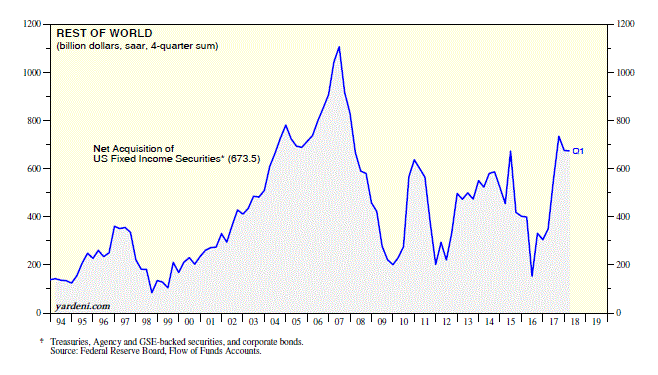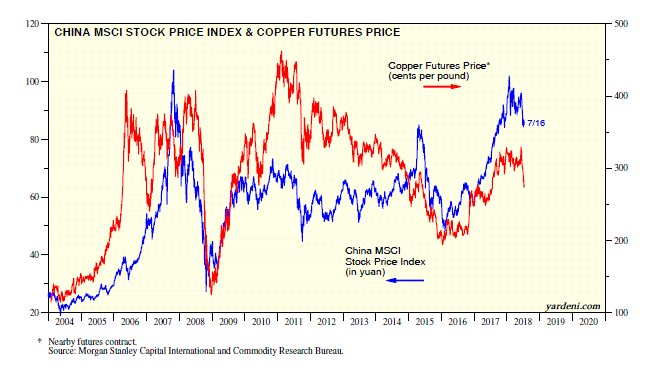
Much like Blanche DuBois in Tennessee Williams’ play “A Street Car Named Desire,” the US has “always depended on the kindness of strangers,” or at least it has for a very long time. That’s because foreigners have been big buyers of bonds issued by Americans. They’ve helped to finance the US federal budget deficit. They’ve also bought lots of mortgage-backed and corporate bonds.
Trump’s escalation of the trade war between the US and all our major trading partners has raised concerns that foreigners will respond to Trump’s “America First” protectionism by cutting back on their purchases of US debt. Furthermore, Trump’s tariffs may boost inflation in the US by increasing the cost of imports. Both possibilities should be bearish for bonds. Yet bond yields remain eerily subdued. Let’s consider why, and also whether tariffs are necessarily inflationary:
(1) Bond yields and expected inflation. The 10-year US Treasury bond yield peaked this year at 3.11% on May 17, and has been trading below 3.00% most of the time since then (Fig. 1). The comparable 10-year TIP yield has mirrored the nominal yield so far this year.
Expected inflation, as implied by the spread of the two yields, has been relatively stable around 2.00% after mostly rising during the second half of 2017 from a low of 1.66% on June 21, and jumping after passage of the Tax Cuts and Jobs Act (TCJA) on December 22 (Fig. 2).
The escalating trade war hasn’t boosted the expected inflation spread, so far, despite Trump’s threat to impose tariffs on lots of Chinese imports. So far, there is no sign that foreigners are bailing out of US debt securities. On the contrary, the outbreak of protectionist saber-rattling, and now jousting, has boosted the trade-weighted dollar (Fig. 3). This suggests that some global investors are taking sides in the trade war, betting that the US will win, if there is a winner, or at least will emerge the least bloodied.
Meanwhile, despite the potential of an escalating trade war to cause a global recession, the credit-quality yield spread between high-yield corporate bonds and the 10-year Treasury bond also remains eerily serene. It’s been in a tight range around 350bps since early 2017 (Fig. 4).
(2) Dr. Copper. The price of copper (a.k.a. “the metal with the PhD in economics”) has been falling since it peaked this year at 329.3 cents per pound on June 8 (Fig. 5). It continued to move lower last week, closing at 277.0 cents, down 15.9% from the recent peak. Since this says more about the economy of China than that of the US, it’s not surprising to see that Chinese stocks are getting hammered (Fig. 6).
Meanwhile, the S&P 500/400/600 are up 8.5%, 10.8%, and 17.1% since their lows on February 8. My switch back to a Stay Home from a Go Global investment strategy on June 4 was well timed, so far, as evidenced by the ratios of the US MSCI to the All Country World ex-US MSCI in both dollars and local currency terms. Both soared to record highs last week (Fig. 7).
(3) Flow of funds. As I discuss in my book, Predicting the Markets, I use the Fed’s quarterly report Financial Accounts of the United States to monitor the flow of funds in the capital markets. The data are currently available through Q1-2018. They show that the “rest of the world” acquired $674 billion in US fixed-income securities over the past four quarters (Fig. 8). That’s among the highest readings since the 2008 financial debacle. The figure includes $332 billion in US Treasuries and $267 billion in corporate bonds (Fig. 9 and Fig. 10).
The consensus view among economists is that Trump is wrong about trade wars. They aren’t “good, and easy to win,” as he tweeted on March 2. It is also widely believed that if he continues to escalate the trade war, everyone will lose because the result is most likely to be stagflation or worse. Weakening global trade will depress global growth, while higher tariffs will boost inflation. I am not dismissing this widely believed narrative. However, while Trump has opened up lots of fronts in his battle for fair trade with America’s major trading partners, the major fight is with China. Will China put up the white flag and make major concessions to get a cease fire out of Trump?
Currently, that seems to be an unlikely scenario. However, that’s exactly the story being told by the financial markets. As noted above, while Chinese stocks are falling, US stocks are rising. The weakness in the price of copper is a better economic indicator for the economy of China than for that of the US.
While the Fed continues to gradually normalize monetary policy, the People’s Bank of China cut reserve requirements sharply in recent weeks (Fig. 11). That undoubtedly contributed to the 6.2% plunge in the yuan from its mid-April peak (Fig. 12).
If Trump does raise the ante by slapping a 10% tariff on $200 billion of imports from China, a stronger dollar relative to the yuan might very well offset most of the inflationary consequences for the US. To add insult to injury, Trump could revive his attacks on China as a “currency manipulator.” However, in my opinion, it is US trade policies, not Chinese intervention, that is weakening the yuan.
Trump knows that a weak yuan could cause the Chinese some real pain, by increasing the yuan cost of buying dollar-priced commodities, especially oil. China’s PPI inflation rate, which was 4.7% on a y/y basis in June, could go higher and put upward pressure on the CPI inflation rate, which was 1.9% last month (Fig. 13).
Meanwhile, in the US, the year-to-date (through 7/13) performances of the S&P 500 sectors suggest that investors are more concerned about rising interest rates resulting from a strong economy than about a trade war depressing the economy (Fig. 14): Information Technology (15.3%), Consumer Discretionary (14.1), Health Care (5.8), Energy (5.7), S&P 500 Index (4.8), Real Estate (-0.1), Utilities (-0.3), Industrials (-2.8), Materials (-3.1), Financials (-3.5), Consumer Staples (-7.8), and Telecom Services (-10.3). Cyclical stocks are mostly outperforming interest-rate sensitive ones.

